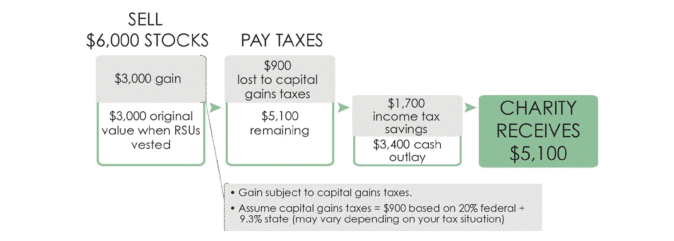Donating Snowflake Stock: Help Charities and Benefit Financially
If you previously exercised your Snowflake Incentive Stock Options (ISOs), you may be sitting on a stockpile of shares with a huge embedded gain.
As COVID continues its rampage across the US, you might be thinking about your charitable giving. On this GivingTuesday, learn how donating your Snowflake stock is a win-win: your favorite charitable organizations benefit, and you benefit financially as well.
The Two Financial Benefits of Donating Stock
Donating your Snowflake stock to charitable organizations benefits you financially in two ways:
- It reduces your income taxes AND capital gains taxes.
- It reduces your concentration in your company stock.
Let’s focus on the tax savings first.
Tax Benefit #1: Reduce Income Taxes
I mentioned two types of tax savings when you donate SNOW:
- Reduced income taxes due to the tax write-off for charitable giving (assuming you itemize).
- Reduced capital gains tax.
We’ll focus on reduced income taxes in this section, and then reduced capital gains in the next section.
Income Taxes 101
Thanks to the 2017 Tax Cuts and Jobs Act, the standard deduction greatly increased. If you want your charitable giving to reduce your income taxes, you need to ensure that you give enough money away such that your itemized deductions is greater than your standard deduction. Download my free guide, Financial Self-Care for Superstar Women, and read the “Quick Primer on Income Taxes” section to learn more.
Donate Cash/Write a Check
Let’s say you’re a single filer who wants to write a $6,000 check to your favorite charity. Because the US government wants taxpayers to donate to charitable organizations, the IRS encourages you by giving you a tax break that reduces your tax bill. Assuming your combined marginal tax rate is 33.3% (24% federal + 9.3% state), you save $2,000 on taxes.
In other words, rather than $6,000 cash going out the door, your outlay will be $4,000 after the tax savings. And the charity still receives the full $6,000.

Sell SNOW, Then Donate the Cash
You may be wondering, “What if I sell $6,000 worth of company stock? Isn’t that the same thing?” The answer is No, and that’s because of capital gains taxes.
Capital gains taxes are different from income taxes. Capital gains taxes apply when you sell investments or property at a gain. Let’s assume the $6,000 of stocks have a $3,000 gain. In other words, the shares that you acquired via ISO exercise were valued at $3,000 on the vesting date(s), and have since grown by $3,000 ($3,000 gain).
When you hold investments for at least one year and one day, long-term capital gains taxes apply. By selling the investments, you lose $900 to capital gains taxes, which lowers your tax write-off, and lowers what the charity receives.

Tax Benefit #2: Reduce Capital Gains Taxes by Donating SNOW Shares Directly
Instead of writing a $6,000 check, you can donate $6,000 of stock directly to a charitable organization. By donating an appreciated security “in-kind,” you receive TWO tax benefits:
- You can still write off the full $6,000 for the income tax deduction.
- You avoid paying capital gains taxes on the gain.

Meanwhile, the charity can sell the stock and pocket the full $6,000. Charities do not pay capital gains taxes because non-profit organizations are exempt from taxes.
Strategies for Donating Your Company Shares
Strategy #1: Donate the “Right” Shares
It’s best to donate stocks that:
- Have grown in value since you acquired them.
- You acquired at least one year ago.
Note on donating SNOW stocks that resulted from ISO exercises: you need to be careful about making sure the stocks meet the two holding period requirements. In other words, the stock donation must be at least two years from the grant date, and at least one year from the exercise date.
Strategy #2: Charitable Lumping
If you want to itemize your charitable giving, you need to donate enough such that itemizing is greater than the standard deduction. For the typical single, high-earning renter in the Bay Area, this means your charitable giving must be at least $2,401 in 2020, and $2,551 in 2021.
Strategy #3: Donor Advised Fund
A Donor Advised Fund is a charitable investment account, which you can open at several financial institutions.
Donor Advised Funds are technically charities. Financial institutions have separate legal entities set up as charitable organizations, which allow you to get the tax write-off (e.g., Vanguard Charitable, Schwab Charitable). You get a tax deduction for the year in which you donated the cash and/or investments.
You can then disburse the funds to the charities of your choice. Contributing to a Donor Advised Fund is a way of front-loading several years of gifts:
- You can disburse the funds as slowly or as quickly as you wish. If you die before the Donor Advised Funds runs out of money, you can name a successor to administer the account.
- You get a tax deduction for the year in which you donated the cash and/or investments to the Donor Advised Fund.
- But you don’t get to take a second deduction when the gift is disbursed to the end charity.
General Notes
- You’re better off donating long-term investments with large capital gains.
- To qualify for the tax savings, the organization must be a non-profit 501(c)(3) organization.
- If you’re subject to blackout periods, you may have to donate your company stock during an open trading window.
To learn more about the Snowflake IPO, here are my other posts in this series:
- Blessings (and Burdens) of a Financial Windfall
- Donating Snowflake Stock: Help Charities, and Benefit Financially
- Snowflake Incentive Stock Options
- Snowflake’s Lock-up is Ending: Prepare for an Emotional Roller Coaster
- Snowflake RSUs
- Which Financial Professional Should You Hire?
- Prepare for the Full Release in March 2021





